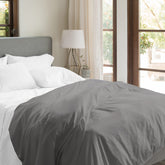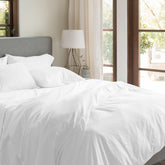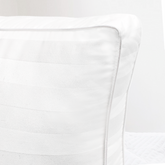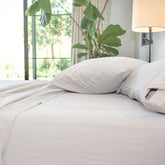No matter our race, gender, location, educational background, vocation, socioeconomic status, or other circumstances, one common factor we all share is that we are influenced by our environments. Our health, relationships, and general level of happiness are all impacted by the spaces we inhabit. And of course, one of the most significant environments we encounter on a regular basis is our home. In fact, research suggests that the average person spends some 63% of their lives inside a home environment! So it’s no wonder that our homes can have a profound impact on our well-being and overall quality of life. That’s why creating a healthy home environment is vital for fostering both physical and mental wellness for you and your loved ones.

Of course, the home you create is more than just what you see; it’s also about what you smell and hear, the textures you touch, the air quality, temperature, and humidity. There are other things that factor into your home environment too, like the level of cleanliness, the ease of movement, and the level of safety and security that you feel when you’re at home. Through the input of your five senses, your environment has a profound impact on your overall state of wellness. In fact, there’s science to prove this, as Harvard University has released a web-based report from its Healthy Buildings Program entitled Homes for Health, where researchers have compiled scientific data that demonstrates the profound influence our homes have on our physical, mental, and emotional well-being. As researcher Joe Allen puts it, “Home is where the heart is. It’s a figurative expression, but it’s literal too because it’s actually where your heart is spending a majority of its time.”

But how can you transform your home environment into a place where you and your family will flourish? The Homes for Health report flags specific areas of focus for each room or section of the home and provides 36 expert tips to help create a healthier home environment.

Creating a Healthier Bedroom
Let’s focus with the bedroom (one of our favorite rooms here at Jennifer Adams!). A restful night's sleep is essential for overall vitality, and a healthier space means better, more restful sleep. Create a sleep-friendly environment by investing in a comfortable mattress, pillows, and breathable bedding.

The Homes for Health report also offers these 5 expert tips for improving the health of your bedroom:
Train your brain. Make your bedroom a conducive sleep environment by removing distractions and things that keep your brain stimulated. For example, put away your electronics, and protect your bedroom as a “work-free,” relaxing zone. Establish a soothing pre-sleep routine, such as reading a book or practicing relaxation techniques, to signal to your body that it's time to unwind.

Black out, and blue out. You’ll rest better in a dark environment, so keep the lights dim. When it’s time for bed, it helps to take advantage of room-darkening shades or a sleep mask. Make sure to limit your exposure to light from blue screens, as well. Studies indicate that blue light stimulates the brain, and can even keep it stimulated for a couple of hours after turning off these devices, too.
Clean the air. Ensure that the air you breathe is clean and healthy. Regularly open windows to promote natural ventilation and let fresh air circulate. Invest in air purifiers or plants known for their air-purifying properties, such as aloe vera, spider plants, or peace lilies. Additionally, avoid using harsh chemical cleaners and opt for natural alternatives or eco-friendly products to minimize indoor air pollution. Adding a portable HEPA air purifier to your bedroom (or using a whole-house air purifying system) can do wonders for helping you to breathe easier and sleep better.

Keep your cool. Setting a night-time target temperature between 65°F to 70°F has been shown to help create a more optimal sleep environment.
Keep it quiet. Block out intermittent or unexpected noise with white noise from an air purifier or fan. You could also try playing some quiet, relaxing music to help get you in the mood for falling asleep.

General Healthy Home Tips
Some of the other tips offered by the report include not wearing shoes in the house, installing detectors for smoke and Carbon Monoxide, and making sure your kitchen is well ventilated with an exhaust hood.
Toxins are another important aspect to consider. Many everyday household items release harmful toxins into the air. Take steps to minimize exposure by choosing furniture and carpets without harmful chemicals, as well as low-VOC (volatile organic compounds) paints. Opt for organic bedding, mattresses, and curtains to minimize contact with potentially harmful chemicals. Vacuum regularly with a HEPA filter, and clean and dust your home to remove allergens and prevent the build-up of harmful particles.

The report also advises us to (re)connect with nature and natural light indoors. In fact, bringing nature indoors has a profound impact on our well-being. Introduce houseplants throughout your home to purify the air and add a touch of greenery. Create a herb garden in your kitchen or place potted plants on windowsills to connect with nature while enjoying the benefits of fresh herbs and improved air quality. Maximize natural light in your home by keeping windows unobstructed, using sheer curtains or blinds, and strategically placing mirrors to reflect sunlight throughout the space.

As you can see, the majority of these tips are simple, inexpensive, and can be implemented immediately. But it all starts with the realization that your overall well-being is directly linked to the quality of your home environment. Your home is an extension of you, so when you take the time to create a nurturing home environment, you’re really helping to nurture yourself. Simple shifts in your habits at home can make a huge impact on the rest of your life, so don’t wait for “someday”; take action now and begin to create a healthier home where you can really thrive!






